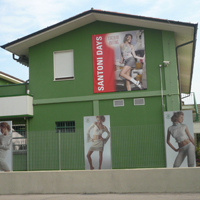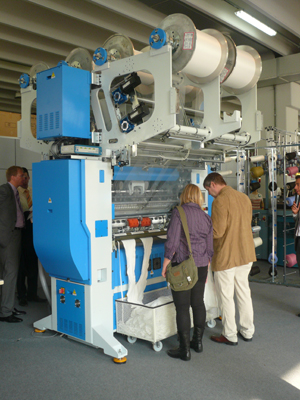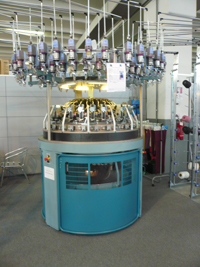
Santoni X-MACHINE for 3D shoe uppers on show at ISPO
20 October 2009, Brescia - Visitor’s to Italy’s hosiery machinery capital were not disappointed when the Santoni Group opened its doors for its established Santoni Days event from 8-10 October. Visitors were introduced to a range of Santoni’s ‘New Age Seamless’ innovations at a well attended show with a positive atmosphere and real international flavour. New seamless warp knit First up from Santoni was a brand new version of its double needle bar warp knit machine for seamless gar

20th October 2009
Knitting Industry
|
 20 October 2009,
Brescia - Visitor’s to Italy’s hosiery machinery capital were not disappointed when
the Santoni Group opened its doors for its established Santoni Days event from
8-10 October. Visitors were introduced to a range of Santoni’s ‘New Age Seamless’
innovations at a well attended show with a positive atmosphere and real
international flavour.
20 October 2009,
Brescia - Visitor’s to Italy’s hosiery machinery capital were not disappointed when
the Santoni Group opened its doors for its established Santoni Days event from
8-10 October. Visitors were introduced to a range of Santoni’s ‘New Age Seamless’
innovations at a well attended show with a positive atmosphere and real
international flavour.
New seamless warp knit
First up from Santoni was a brand new version of its double needle bar warp knit machine for seamless garment manufacture. Its SWD8, which was showcased at last year’s Santoni Days, has now been superseded with the updated and much improved SWD4/2J.
According to Santoni, the main improvements are the machine speed, which is now up to 800rpm, and the new guide bar layout, where the piezo jacquard mechanism is now fitted on two guide bars only for greater patterning flexibility. The new SWD4/2J is available in both 24 and 28 gauge and has a working width of 44 inches. Electronic patterning is by means of piezo elements and the new machine has extra compact dimensions of 2300mm wide x 3110mm deep x 3200mm high.
 Santoni says that one of the main advantages of the SWD4/2J
is that a faulty piezo unit can be replaced individually very quickly and there
is no need to remove all units to replace a faulty one. There is also no need
to adjust the piezo unit after replacement, the company says. Both yarn let off
and fabric take up devices are electronically controlled and guide bar shogging
is controlled by linear motors as before.
Santoni says that one of the main advantages of the SWD4/2J
is that a faulty piezo unit can be replaced individually very quickly and there
is no need to remove all units to replace a faulty one. There is also no need
to adjust the piezo unit after replacement, the company says. Both yarn let off
and fabric take up devices are electronically controlled and guide bar shogging
is controlled by linear motors as before.
The SWD4/2J is now in series production and Santoni says that interest in its double needle bar seamless machine concept is split between its own circular seamless customers, raschel users and even users of seamless flat knitting machines. Dinema Spa, another Lonati Group company, has developed a new programming system for double needle bar raschel machines which was on show alongside the SWD4/2J. The system works in a similar way to flat knitting machine programming systems where the user draws the knitting data on the screen stitch by stitch. Various designated colours are assigned for knitting, guide bar shogging and connection points where front and rear needle bar fabrics join to create seams in the garment.
High production knitwear machine
 One of Santoni’s most interesting innovations at the show
was the brand new SM6-RIB2, a double knit, cylinder and dial, electronic
circular knitting machine with 6 feeds, suitable for seamless outerwear such as
knitwear with true rib border. The cylinder has needle by needle individual
selection for three way technique, for high definition and floating yarn
patterning. According to Santoni the machine is suitable for using both natural
and synthetic yarns as well as covered and uncovered elastane.
One of Santoni’s most interesting innovations at the show
was the brand new SM6-RIB2, a double knit, cylinder and dial, electronic
circular knitting machine with 6 feeds, suitable for seamless outerwear such as
knitwear with true rib border. The cylinder has needle by needle individual
selection for three way technique, for high definition and floating yarn
patterning. According to Santoni the machine is suitable for using both natural
and synthetic yarns as well as covered and uncovered elastane.
The machine on show was a 14 gauge, 18 inch diameter with 6 feeds. The SM6-RIB2 machine was knitting a ‘skinny rib’ polo neck sweater in 100% Cotton (Ne 46/2 x 2) from Emil Cotton, with the knit time for the body approximately 3 minutes and an overall knitting time of 6 minutes being estimated for the complete garment. The machine knits a garment length with welt and true rib border and is pressed off at the end of knitting of each garment length. The machine is able to knit any number of rib set outs and cutting lines for armhole and sleeves can be programmed in to the knit data. The machine is however still at the prototype stage but looks like a very interesting development for high production knitwear manufacture.
 New SM9 rib options
 Next up from Santoni was the SM9-MF, which replaces the well
known SM9. This is a double knit electronic circular knitting machine for seamless
rib knitting in underwear and outerwear both in continuous tubular fabric and
in separate pieces or garment lengths, with single welt and separation yarn.
Santoni says that the machine is capable of knitting all kinds of rib as well
as inlaid structures due to its individual needle selection on the cylinder
with three way technique and two way technique in the dial (miss-needle-knit or
miss-needle-tuck) and transfer position.
Next up from Santoni was the SM9-MF, which replaces the well
known SM9. This is a double knit electronic circular knitting machine for seamless
rib knitting in underwear and outerwear both in continuous tubular fabric and
in separate pieces or garment lengths, with single welt and separation yarn.
Santoni says that the machine is capable of knitting all kinds of rib as well
as inlaid structures due to its individual needle selection on the cylinder
with three way technique and two way technique in the dial (miss-needle-knit or
miss-needle-tuck) and transfer position.
Santoni says that the SM9-MF is also both cheaper and more productive than its predecessor the SM9. The machine on show was a 20 gauge model in 16 inch diameter. Various feeder configurations are available for the SM9-MF. For example, machines with 16 inch to 18 inch diameters are configured 8 knit feeders and 4 transfer feeders, a total of 12 feeders, one of which is integral, i.e. knit and transfer. Another configuration possibility is 6 knit feeders and 6 transfer feeders. Also new for this model is the inclusion of LGL Compact  yarn feeding and control devices.
At the show Santoni also introduced the SM9-MF’s sister machine, the SM9-MFS and showed a 14 gauge, 16 inch, 8 feed model. Again the machine is a cheaper and all electronic but more versatile option than the SM9. Whereas the SM9-MF has three way technique in the cylinder, the SM9-MFS has two way technique in both cylinder and dial. The machine on show was equipped with SJFB yarn feed units and according to Santoni is sought after by Chinese manufacturers in particular. The SM9-MFS is already in production.
SM8 TR1
Santoni also showed a new version of its SM8-TR1 seamless transfer machine which caused a lot of interest at its launch. The SM8-TR1 is now an 8 feed single jersey circular electronic machine available from 16 inch to 20 inch diameter with two selection points (3 way technique) for the knitting feeder plus one selection point for the production of Santoni’s patented fish-net or anti-drop stitch structures. The machine allows for the knitting of seamless-wear, swimwear, sportswear and sanitary wear garments. The machine on show was a 24 gauge, 16inch model, which was producing a polypropylene/ Trevira sportswear garment.
SM4-TL2 for smooth intarsia Â
 Another innovative prototype on show was the SM4-TL2, 4 feed
single jersey circular electronic machine, with 2 selection points for the
knitting of fishnet or anti-drop stitch structures (Santoni patent). According
to Santoni the machine allows knitting of seamless wear single garments for
underwear, outwear, swimwear, sportswear and sanitary garments. The machine
uses Santoni’s patented system that allows knitting with 4 feeds for patterns with
highly defined and sharp coloured outlines. The machine can knit a single or
double welt carried out with jacks, in several selections, with knitted,
floated or laid-in elastic yarn.
Another innovative prototype on show was the SM4-TL2, 4 feed
single jersey circular electronic machine, with 2 selection points for the
knitting of fishnet or anti-drop stitch structures (Santoni patent). According
to Santoni the machine allows knitting of seamless wear single garments for
underwear, outwear, swimwear, sportswear and sanitary garments. The machine
uses Santoni’s patented system that allows knitting with 4 feeds for patterns with
highly defined and sharp coloured outlines. The machine can knit a single or
double welt carried out with jacks, in several selections, with knitted,
floated or laid-in elastic yarn.
 The machine has a reciprocating movement which allows it to knit intarsia in a similar way to a flat knitting machine with 1, 2, 3 or 4 needle overlap or tuck joins. The machine on show was knitting a stunning red and black fitted sportswear garment in 26 gauge plaited single jersey. Santoni aims to further develop the SM4-TL2 to allow the creation of medical and sportswear garments with zones having varying compression levels. The black and red intarsia pattern had clean crisp joins and was enhanced by plaiting black elastane with the black ground yarn and ‘white’ elastane with the red ground yarn. According to Santoni, the major advantages are that the garment gives excellent ‘next to skin’ comfort thanks to almost seamless intarsia joins and that compression can be maintained due to the seamless nature of the garment.
Automatic assembly of knee-highs and pantyhose
Another highlight of the show was the Santoni Group’s integrated system for the automatic assembly of knee-highs and pantyhose, which consists of the P&P-SG Pick & Place with automatic loader, the TC8 or TC10 automatic toe closer and the SB10 automatic boarding machine.
Santoni’s Finishing Machines Sales Manager, Fabrizio Paleologo told Knitting Industry: “Although the individual machines are not new, this is the first time that Santoni has offered a fully-integrated solution. The P&P-SG automatically loads the toe closer with either knee highs or pantyhose. It picks up the products and orients them (welt and toe) and feeds them to the toe closer. The TC8 (8 tubes) or TC10 (10 tubes) automatically seams the product and feeds it to the SB10 boarding machine which automates the boarding process giving cost reductions and financial advantage.”
Santoni, which was European agent for Takatori hosiery assembly systems until it withdrew from the market, is now a full service solutions provider in the field and is aiming to increase market share significantly.
Matec
On show from Santoni Group company Matec was the latest version of its very well known Perfect Toe, double cylinder automatic closed toe sock knitting machine, which is still in good demand according to the company. The fully electronic Perfect Toe knits rib and links socks and the latest version encompasses new software for improved ease of use and improved stitch cam angles for superior plaiting technique. The Perfect Toe on show was toe closing using a 38/2 cotton and 78/2 nylon combination.
Also on show from Matec was the much sought after 4 feed Pendolina Super for compression hosiery. The compression gradient is created in the legwear by vertical cylinder and dial movement and adjustment of the elastane feed.
MecMor
 Circular open width garment length machine builder MecMor
showed its latest MecMor Variatex 1800-N, 20 system machine. The 42 inch diameter
14 gauge machine on show was knitting a women’s patterned sweater in 7 minutes
16 seconds. New to the Variatex 1800-N is a new takedown and electronically
controlled yarn finger which allows MecMor’s knitting width reduction from the
programming system. MecMor’s width reduction allows the user to increase or
decrease the number of body panes knitted simultaneously according to size and
quantity demand. MecMor also demonstrated its newly introduced software with
real stitch simulation which it has developed in conjunction with Logica.
Circular open width garment length machine builder MecMor
showed its latest MecMor Variatex 1800-N, 20 system machine. The 42 inch diameter
14 gauge machine on show was knitting a women’s patterned sweater in 7 minutes
16 seconds. New to the Variatex 1800-N is a new takedown and electronically
controlled yarn finger which allows MecMor’s knitting width reduction from the
programming system. MecMor’s width reduction allows the user to increase or
decrease the number of body panes knitted simultaneously according to size and
quantity demand. MecMor also demonstrated its newly introduced software with
real stitch simulation which it has developed in conjunction with Logica.
Vignoni
Santoni Group’s Vignoni circular knitting machine builder was also present with new additions to its range at the show. The all new single jersey Atlas was shown in 54 gauge without sinkers. The Atlas which Vignoni says can run at speeds of up to 45 rpm uses and undercomb device for quick restart after press off. The company’s Atlas models in standard 28 and 32 gauge are also likely to move to the ‘no sinker’ format.
Also on show from Vignoni were new additions, 24 and 28 gauge Orion rib machines. The model on show was a 28 gauge, 30 inch, 60 feed machine. Vignoni’s Pulsar interlock machine, which is particularly popular in Italy and South America, is used for the production of swimwear fabrics in polyamide/ elastane blends. The company aims for a balance between quality and productivity and showed a 50 gauge model in 34 inch diameter in 96 feeds.
Also exhibited were the company’s Atlas HS high speed single jersey in 28 gauge, which sells well in Brazil and the budget Panda which is made in Santoni’s own factory in China. The company’s versatile fast change Iris striper was also shown in 28 gauge, 30 inch, 48 feeds. The Iris, which has a pneumatic selection system much like a sock machine or MecMor machine, is unique in that it can make multiple striped panels at the same time which makes it ideal for fast sampling, the company says.
Santoni’s research and development efforts have clearly been stepped up significantly and it will be interesting to see how the company’s latest offer fares when the global economy picks up. Initial feedback from the company’s customers who attended Santoni Days is reported as being very promising.

Business intelligence for the fibre, textiles and apparel industries: technologies, innovations, markets, investments, trade policy, sourcing, strategy...
Find out more